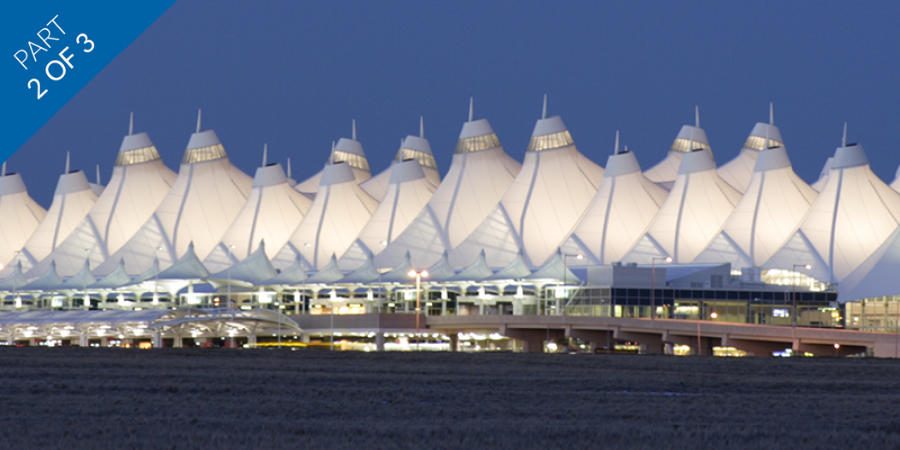
PART TWO - THE HISTORY OF TENSILE FABRIC STRUCTURES

In part two of our three-part series, we will be looking at tensile fabric structures, including the innovation history in materials as well as techniques. We will also be showcasing one exceptional tensile structure to discuss its effect on tensile architecture. Discover part one: Tensile Architecture Innovation: The History of Tensile Fabric Structures.
Tensile Architecture Innovation: The History of Tensile Materials and Techniques
Tensile structures are anticlastic forms, characterised by flexible fabric membranes which are supported by cables, a structural steel framework and foundations. With innovative advances in materials and engineering techniques, tensile architecture can be designed in a variety of styles, shapes and sizes.
The origins of fabric structures can be traced back at least 40,000 years where the remains of simple shelters constructed from animal skins draped on a wooden frame or large bones from nomadic people have been found. 30,000 years later, woven fabrics were first incorporated in tents. Historically, these simple tents differ in building materials and techniques, depending on the climate where constructed. The Native American tipi is considered a masterpiece in structural design and was constructed using buffalo skins over a cone-shaped wooden frame structure.
Whilst the Native Americans were perfecting the cone design, nomadic desert tribes in Northern Africa and the Middle East, like the Bedouins, were developing “black tents”. Traditionally made from camel leather draped over tension ropes and supported by a series of poles, the black tents received their name from the black goat hair woven coarsely into a breathing membrane. The loosely woven cloth allowed for air to pass through, whilst providing shade and protection from the rain. This marvelous adaption of simple materials created natural ventilation inside the tent, a real innovation for the hot climate of the Saharan Desert.
Historically, more complex fabric structures were predominately the craftsman’s trade and not the domain of the architects. This focus was to shift in the nineteenth and twentieth centuries as architects became inspired by technological breakthroughs in structural engineering.
Horst Berger, structural engineer and designer known for his lightweight tensile architectural work, is credited for the introduction of tensioned fabric structures into modern architecture. In the 1970s, Berger mathematically determined the shape of a tensioned fabric structure. Berger is responsible for some of the first, biggest and most beautiful tensile structures in the world, including the Haji Terminal at the King Abdulaziz International Airport in Saudi Arabia which incorporates 21 “tents” of white Teflon-coated fiberglass fabric suspended from pylons, accommodating up to 80,000 travelers at once.
Denver International Airport
One of Berger’s most iconic projects is the beautiful tensile membrane roof at Denver International Airport. Berger provided a specialised roof design and engineering to support Fentress Bradburn Architects for this project. The principle design concept was to incorporate forms and materials indigenous to the environment and culture of the Rocky Mountain region surrounding the airport complex, creating a unique feeling of space. Harmony between the interior and exterior was achieved through the fusion of two natural elements – form and light. The nine-acre roof with its dramatic peaks and valleys give it a unique shape emulating the profile of the Rocky Mountains.
On a practical level, the unique tensile membrane roof designed resulted in a cost-effective project with reduced construction time, durability and improved energy efficiency over traditional building materials and techniques. The double-layer lightweight Teflon® PTFE-coated fiberglass membrane roofs allow for a greater span than traditional roofing systems. PTFE was chosen because this fabric membrane is an extremely durable, weather resistant and highly sustainable material for roofing applications. It can be installed in climates ranging from the frigid arctic to the scorching desert heat.
Tensile Fabric Structures with J & J Carter
The versatility of tensile architecture is what makes it so unique, allowing for the design of existing and practical roof forms that would be almost impossible with traditional building methods.
Working alongside the client's professional advisors, we can provide architectural solutions using the latest in fabric developments. With an in-house team of structural engineers, project managers, installers, designers, membrane fabricators and steel/aluminum fabricators, we provide a single source of supply for architectural fabric tent structures.
Please contact us to learn more about our full array of unique, award-winning and location enhancing structures we have produced for a range of organisations.
